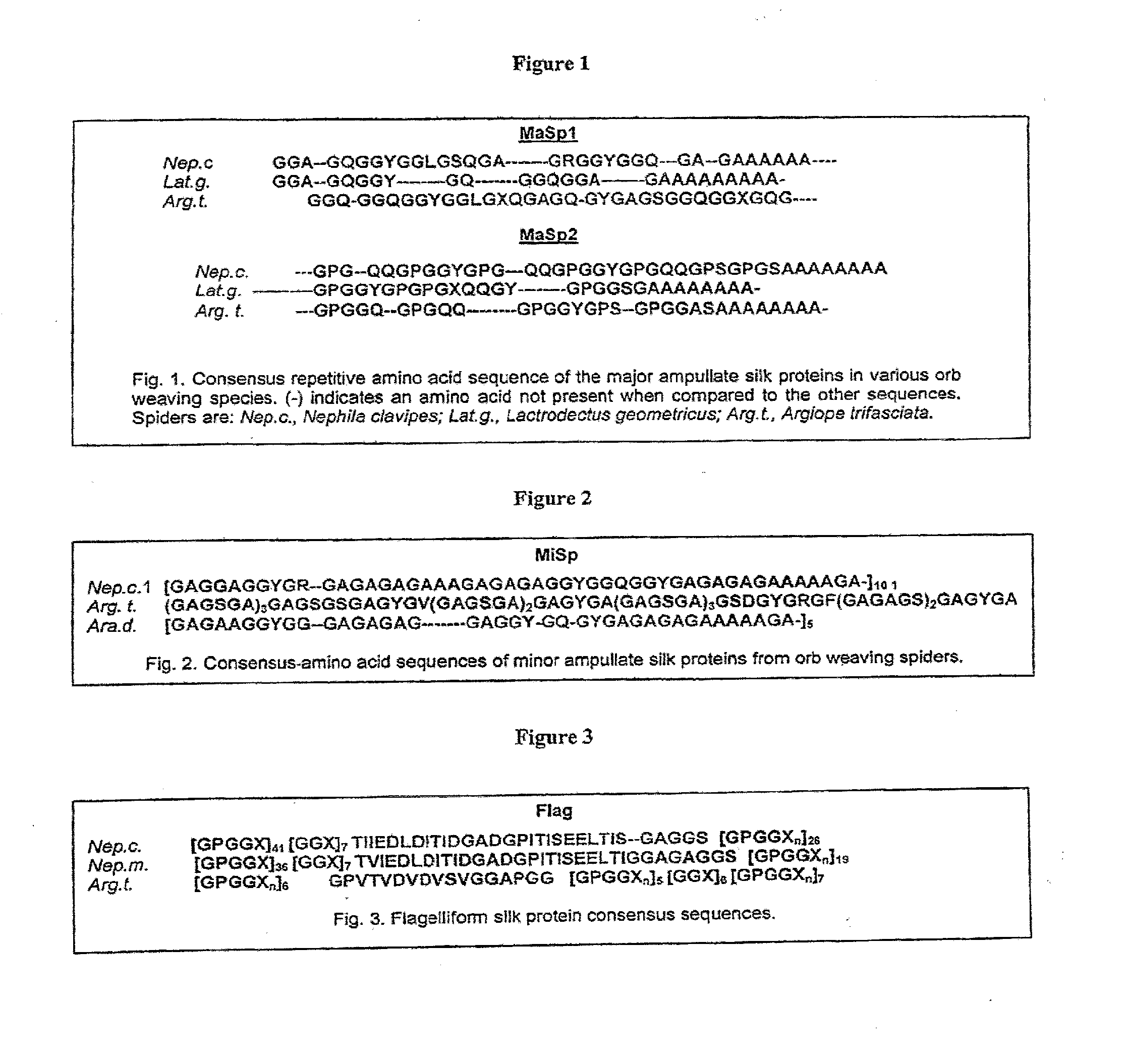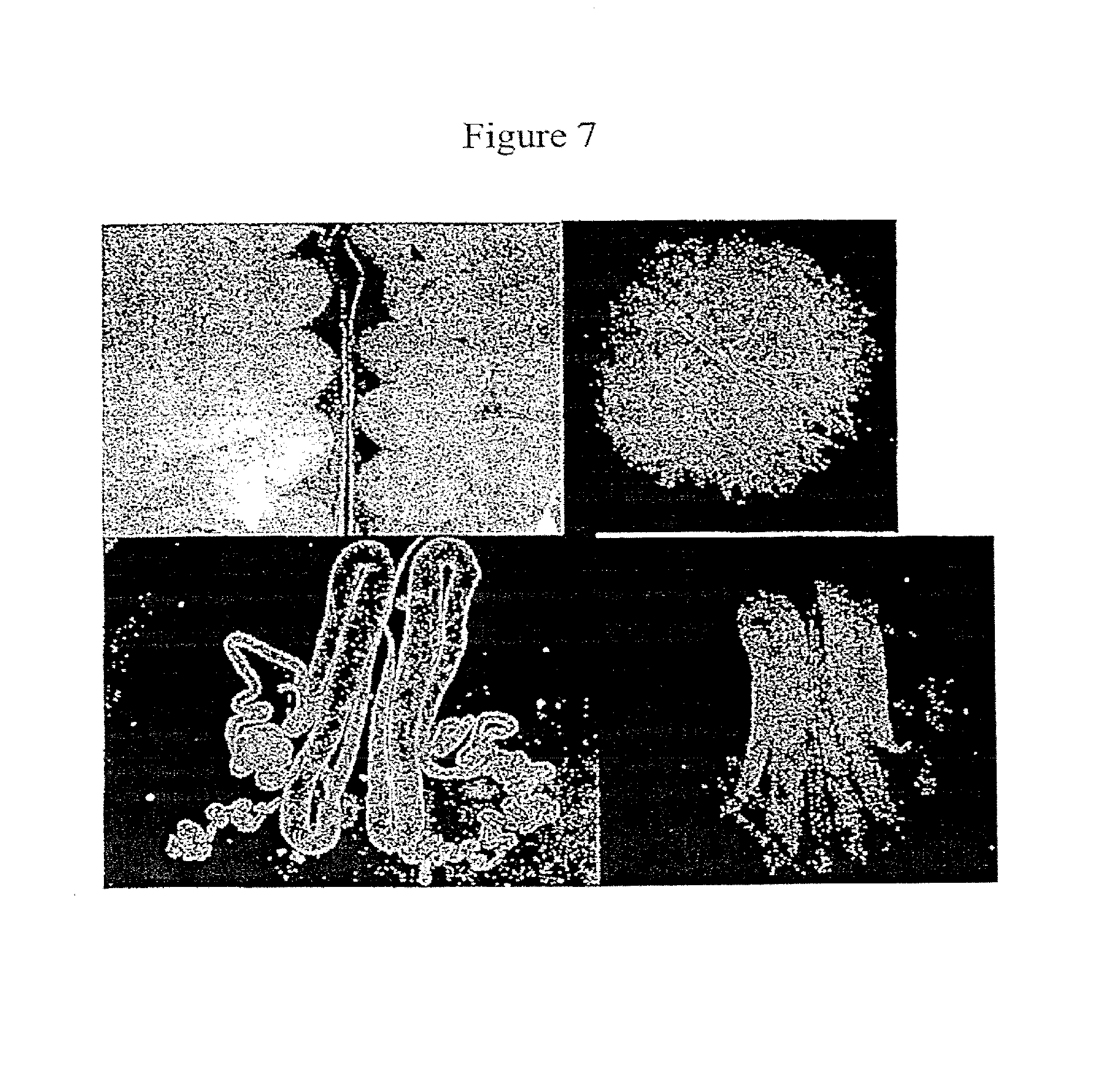Chimeric spider silk and uses thereof
a technology of spider silk and silk fiber, applied in the field of silk fiber, can solve the problems of reducing the number of silk fibers produced, so as to achieve the effect of facilitating screening using fluorescence genes
- Summary
- Abstract
- Description
- Claims
- Application Information
AI Technical Summary
Benefits of technology
Problems solved by technology
Method used
Image
Examples
example 1
Materials and Methods
[0083]The present example is provided to describe the materials and methods / techniques employed in the creation of the transgenic silkworms, the general procedures employed in the creation of the genetic constructs employed, as well as reference tables used in the assessment of tensile strength of the transgenic spider silk fibers.
[0084]1. The gene sequences used. The gene sequences used are provided in the FIGS. 13-16 provided herein. Variations of these are also envisioned as part of the present invention, as it is contemplated that shorter and / or longer versions of these sequences may be employed having conservative substitutions, for example, with substantially the same chimeric spider silk protein properties.
[0085]2. The chimeric spider silk proteins and the fibers obtained with these chimeric silk proteins will be assessed for tensile strength. Table 1 provides a general reference against with the chimeric spider silk fibers will be assessed. The chimeric ...
example 2
Analysis of the Tensile Strength Properties of Individual Transformed Silkworm Silks
[0086]Transgenic silkworm silks were analyzed for the presence of the spider silk chimeric protein by Western blotting of both the silkworm silk gland protein contents and the silk fibers from transgenic silkworm cocoons using a spider silk-specific antibody. In both cases transgenic silkworms were verified as producing the chimeric proteins, and differential extraction studies showed that these proteins were integral components of the transgenic silk fibers of their cocoons. Furthermore, expression of each of the chimeric green fluorescent protein fusions was apparent in both silk glands and fibers by direct examination of the silk glands or silk fibers using a fluorescent dissecting microscope. In most cases the amount of fluorescent protein in the fibers was high enough to be visualized by the green color the cocoons under normal lighting.
[0087]Table 2 shows an analysis of transgenic silks produce...
example 3
Silkworm Chimeric Gene Expression Cassettes and PiggyBac Vectors for Chimeric Spider Silk / Silkworm Protein Expression in Transgenic Silkworms
[0088]The present example is provided to demonstrate the utility and scope of the present invention in providing a vast variety of silkworm chimeric spider silk gene expression cassettes. The present example also demonstrates the completion of piggyBac vectors shown to successfully transform silk worms, and result in the successful production of commercially useful chimeric spider silk proteins suitable for the production of fibers of commercially useful lengths in manufacturing.
The expression cassettes.
[0089]Several variations on the basic expression cassettes shown below were constructed. These constructs reflect an assembly of constructs designed to express fibroin heavy chain (fhc)-spider silk chimeras, in which the synthetic spider silk protein sequence is flanked by N- and C-terminal fragments of the B. mori fhc protein. In this regard, s...
PUM
| Property | Measurement | Unit |
|---|---|---|
| Strength | aaaaa | aaaaa |
| Therapeutic | aaaaa | aaaaa |
| Elasticity | aaaaa | aaaaa |
Abstract
Description
Claims
Application Information
 Login to View More
Login to View More - R&D
- Intellectual Property
- Life Sciences
- Materials
- Tech Scout
- Unparalleled Data Quality
- Higher Quality Content
- 60% Fewer Hallucinations
Browse by: Latest US Patents, China's latest patents, Technical Efficacy Thesaurus, Application Domain, Technology Topic, Popular Technical Reports.
© 2025 PatSnap. All rights reserved.Legal|Privacy policy|Modern Slavery Act Transparency Statement|Sitemap|About US| Contact US: help@patsnap.com



